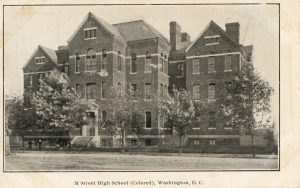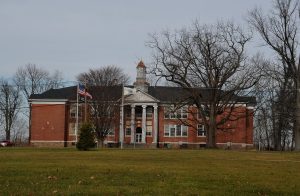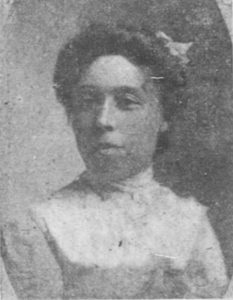Gladys Christine Fearing (1893-1924) was a pianist and teacher in early 20th century New Jersey and Washington, DC. Fearing was a 1911 graduate of the Washington Conservatory of Music whose life exemplifies the racial uplift ideals upon which the Conservatory was founded. Due to her early death at age 29, little information exists, especially letters and other personal ephemera. Despite this lack of information, it is evident that Fearing made an impact in vibrant Black musical communities.
Fearing was born in Washington, DC, in December 1893 to Warren G. Fearing and Mary Fearing.1 Her mother did not work, but her father was a government copyholder who became a Treasury Department messenger.2 This family connection to the government demonstrates that Fearing grew up in the Black upper class. At age 11, Fearing was a bridesmaid at the wedding of Ida Gibbs and William Henry Hunt.3 Gibbs was the daughter of Mifflin W. Gibbs–the first Black judge in the country–and the sister of Washington Conservatory founder Harriet Gibbs Marshall. William Henry Hunt was the U.S. consul to Madagascar. Even as a child, Fearing found herself at events of the Black elite–specifically with her future Conservatory teacher. This wedding suggests that the Fearing and Gibbs families existed in the same social network for some time. Both families had a high social status and emphasized racial uplift ideals, which were often passed down through powerful families like theirs.4

M Street High School, postcard, May 22, 2020, accessed June 25, 2022, https://www.flickr.com/photos/streetsofdc/49934502636/.
One core tenant of racial uplift ideals was schooling, as education and social refinement determined the elite in Black communities.5 Fearing graduated from M Street High School and the Washington Conservatory of Music in 1911 with a degree in Piano and Theory.6 Though not much information exists on Fearing’s musical opinions, her attendance at the Washington Conservatory likely instilled in her the idea of classical music being high class. This perspective was common among other Black intellectuals and classical musicians of the time, such as Nora Douglas Holt.7
Fearing’s education did not stop after the Washington Conservatory. That fall, she enrolled at Howard University with a scholarship, graduating Magna cum laude with an A.B. teachers’ diploma in education in 1915.8 While many Washington Conservatory graduates became teachers, Fearing’s continued education at Howard reflects the depth of racial uplift ideals. Black women, especially, sought education to become teachers. Fearing, then, was part of a broader early 20th-century movement of Black women going into teaching as a profession seen as respectable.9

Jerrye Klotz and Roy Klotz, New Jersey Manual Training and Industrial School for Colored Youth, Photo, January 20, 2013, Own work, accessed June 25, 2022, https://commons.wikimedia.org/wiki/File:NEW_JERSEY_MANUAL_TRAINING_AND_INDUSTRIAL_SCHOOL_FOR_COLORED_YOUTH.jpg.
After leaving Howard, Fearing was appointed as a music teacher at Bordentown Manual Training and Industrial School in New Jersey from 1915-19, and then at Dunbar High School in Washington, D.C., from 1919 until her death in 1924.10 Fearing was one of the “anonymous infrastructure” of Black women who went from musical institutions like the Washington Conservatory and influenced the musical values of Black communities through schools.11 Fearing’s teaching journey exemplifies why Marshall founded the Washington Conservatory of Music and School of Expression. One of Marshall’s goals was “the thorough training of gifted negroes who will use negro music in education institutions, especially in the southern states.” 12
While Fearing passed away at age 29, she likely made a significant undocumented impact on the musical communities in which she participated in New Jersey and Washington, D.C. Fearing’s path through education as a member of the Black upper class was part of a trend in Black musical life grounded in racial uplift ideals. Gladys Fearing may have lived a relatively short life, but it was rich in meaning. Her teaching influenced music in Black communities and exemplified the uplift ideals upon which the Washington Conservatory was founded.
1 Year: 1900; Census Place: Washington, District of Columbia; Roll: 162; Page: 11; Enumeration District: 0105; FHL microfilm: 1240162
2 Ibid; Year: 1910; Census Place: Washington, District of Columbia; Roll: T624_153; Page: 13B; Enumeration District: 0163; FHL microfilm: 1374166
3 “Consul to Madagascar Weds Ida B. Gibbs,” The Washington Times (Washington, D.C., April 13, 1904), 4.
4 Sarah Schmalenberger, “Shaping Uplift Through Music,” Black Music Research Journal 28, no. 2 (2008): 65, https://www.jstor.org/stable/25433806.
5 Kristen M. Turner, “Class, Race, and Uplift in the Opera House: Theodore Drury and His Company Cross the Color Line,” Journal of Musicological Research 34 (2015): 338, https://doi.org/10.1080/01411896.2015.1082380.
6 “Urges Colored Graduates To Stand For Progress,” The Washington Herald (Washington, D.C., June 22, 1911), 7; Joseph Douglass, “Conservatory Has Commencement,” The New York Age (New York City, June 29, 1911), 6.
7 Lucy Caplan, “‘Strange What Cosmopolites Music Makes of Us’: Classical Music, the Black Press, and Nora Douglas Holt’s Black Feminist Audiotopia,” Journal of the Society for American Music 14, no. 3 (2020): 318, https://doi.org/10.1017/S1752196320000218.
8 “Urges Colored Graduates To Stand For Progress,” The Washington Herald (Washington, D.C., June 22, 1911), 7; “Crisis For Nation Also Opportunity,” Evening Star (Washington, D.C., June 3, 1915), 9.
9 Sarah Schmalenberger, “The Washington Conservatory of Music and African-American Musical Experience, 1903-1941” (PhD Diss., University of Minnesota, 2004), 214, https://www.proquest.com/dissertations-theses/washington-conservatory-music-african-american/docview/305157247/se-2?accountid=351.
10 Savannah Tribune (Savannah, Georgia, September 18, 1915), 7; “Board Prepares for School Year,” Evening Star (Washington, D.C., September 4, 1919), 5.
11 Sarah Schmalenberger, “The Washington Conservatory of Music and African-American Musical Experience, 1903-1941” (PhD Diss., University of Minnesota, 2004), 215, https://www.proquest.com/dissertations-theses/washington-conservatory-music-african-american/docview/305157247/se-2?accountid=351.
12 Howard University Moorland Spingarn Research Center, Washington Conservatory of Music Papers, Box 112-3, Folder 117.

You must be logged in to post a comment.